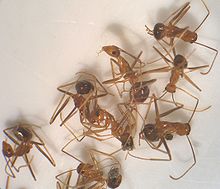| Anoplolepis gracilipes | |
|---|---|

| |
| Scientific classification | |
| Domain: | Eukaryota |
| Kingdom: | Animalia |
| Phylum: | Arthropoda |
| Class: | Insecta |
| Order: | Hymenoptera |
| Family: | Formicidae |
| Subfamily: | Formicinae |
| Genus: | Anoplolepis |
| Species: | A. gracilipes
|
| Binomial name | |
| Anoplolepis gracilipes F. Smith, 1857
| |
| Synonyms | |
|
Formica longipes | |
The yellow crazy ant (Anoplolepis gracilipes), also known as the long-legged ant or Maldive ant, is a species of ant, thought to be native to West Africa or Asia. They have been accidentally introduced to numerous places in the world's tropics.[2][3]
The yellow crazy ant has colloquially been given the modifier "crazy" on account of the ant's erratic movements when disturbed. Its long legs and antennae make it one of the largest invasive ant species in the world.[1][4]
Like several other invasive ants, such as the red imported fire ant (Solenopsis invicta), the big-headed ant (Pheidole megacephala), the little fire ant (Wasmannia auropunctata), and the Argentine ant (Linepithema humile), the yellow crazy ant is a "tramp ant", a species that easily becomes established and dominant in new habitat due to traits such as aggression toward other ant species, little aggression toward members of its own species, efficient recruitment, and large colony size.[5]
It is on a list of "one hundred of the world's worst invasive species" formulated by the International Union for Conservation of Nature (IUCN),[6] having invaded ecosystems from Hawaii to the Seychelles, and formed supercolonies on Christmas Island in the Indian Ocean.[7]
In 2023, a scientific article postulated a unique reproductive cycle for A. gracilipes, suggesting that males are obligate chimeras.[8]
- ^ a b Anoplolepis gracilipes. Global Invasive Species Database. ISSG.
- ^ Davies, Ella. "Battle of the Ants". BBC. Retrieved 2021-08-05.
- ^ "One Remote Island's Battle Against Acid-Spewing Ants". Audubon. 2015-06-26. Retrieved 2022-04-02.
- ^ "Pests and Diseases Image Library: Anoplolepis gracilipes". Archived from the original on 2008-07-29.
- ^ Kirschenbaum, R. and Grace, J. K. 2008. "Agonistic responses of the tramp ants Anoplolepis gracilipes, Pheidole megacephala, Linepithema humile, and Wasmannia auropunctata (Hymenoptera: Formicidae)" (PDF). Sociobiology. 51 (3): 673–84.
{{cite journal}}: CS1 maint: multiple names: authors list (link) CS1 maint: numeric names: authors list (link) - ^ One Hundred of the World's Worst Invasive Alien Species. Global Invasive Species Database. Invasive Species Specialist Group (ISSG), IUCN Species Survival Commission.
- ^ Cite error: The named reference
Aus-ISC-push-backwas invoked but never defined (see the help page). - ^ Cite error: The named reference
Darras_etalwas invoked but never defined (see the help page).